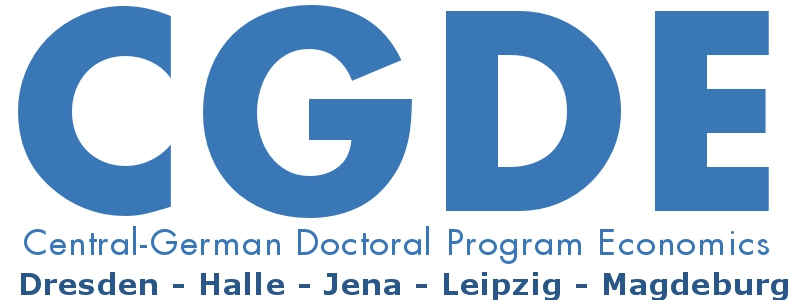Empirical Time Series Methods for Macroeconomic Analysis
Lecturer: Professor Luca Gambetti, PhD (Universitat Autònoma de Barcelona)
Date: October 4, 2016 – October 7, 2016
Venue: Halle Institute for Economic Research (IWH) – Member of the Leibniz Association, Kleine Maerkerstrasse 8, 06108 Halle (Saale), Germany, conference room (ground floor)
Registration: until August 15, 2016 via email: annett.hartung@iwh-halle.de. The course is designed for at most 25 participants.
Announcement see pdf
Course outline
The objective of the course is twofold. First, to present some of the most popular time series models designed to analyze the propagation mechanisms and measure the effects of macroeconomic shocks. In particular, we will cover Structural Vector Autoregressive models as well as several extensions like the Factor Augmented VAR, Smooth Transition VAR, Threshold VAR and Time-varying Coefficients VAR. The second objective is to discuss some recent applications of these models in macroeconomics. The focus will be on monetary and fiscal policy shocks, news shocks and technology shocks among others. Matlab programs to implement the theoretical methods and replicate the applications studied in class will be made available to students.
Schedule
Each day, 9:00–12:00 and 14:00–16:00
Requirement
Basic knowledge of econometrics and time series econometrics.
Contents
I. Structural VAR (SVAR) models
Preliminaries, representation, estimation, identification: short-run restrictions, long-run restrictions, sign restrictions, penalty function approach, mixed
restrictions, the Stock and Watson approach, narrative approach
II. Structural VAR (SVAR) models
Applications, monetary and fiscal policy shocks, technology shocks and news shocks, uncertainty shocks
III. Factor Augmented VAR (FAVAR)
Representation, estimation, inference, applications: monetary policy shocks and the price puzzle, monetary policy and state-level house prices, credit market
shocks, micro-level bank behavior and aggregate shocks
IV. Threshold VAR (TVAR) and Smooth Transition VAR (STVAR)
Application: fiscal policy shocks in booms and recessions
V. Time-varying Coefficients models
Theory, applications: the Great Moderation, monetary policy and stock market bubbles
References
Auerbach, A. and Y. Gorodnichenko (2012): Measuring the Output Responses to Fiscal Policy, American Economic Journal: Economic Policy, American Economic Association, vol. 4(2), pp. 1-27, May.
Bernanke, B. S., Boivin, J. and Eliasz, P. (2005): Measuring monetary policy: a factor augmented autoregressive (FAVAR) approach, The Quarterly Journal of Economics 120, pp. 387-422.
Blanchard, O.J. and R. Perotti (2002): An Empirical Characterization of the Dynamic Effects of Changes in Government Spending and Taxes on Output, The Quarterly Journal of Economics, pp. 1329-1368.
Boivin, J., M. P. Giannoni and I. Mihov (2009): Sticky Prices and Monetary Policy: Evidence from Disaggregated US Data, American Economic Review, American Economic Association, vol. 99(1), pp. 350-84.
Boivin, J., M. P. Giannoni and D. Stevanovic (2013): Dynamic Effects of Credit Shocks in a Data-Rich Environment, CEPR Discussion Papers 9470, C.E.P.R. Discussion Papers.
Buch, C. M., S. Eickmeier and E. Prieto (2014): Macroeconomic Factors and Microlevel Bank Behavior, Journal of Money, Credit and Banking, Blackwell Publishing, vol. 46(4), pp. 715-751.
Burnside, C., M. Eichenbaum and J. D. Fisher (2004): Fiscal Shocks and Their Consequences. Journal of Economic Theory 115, 89-117.
Canova F., Gambetti L. (2009): Structural Changes in the US Economy: Is There a Role for Monetary Policy?. Journal of Economic Dynamics and Control, 33(2), pp. 477-490.
Cogley T. Sargent T. J. (2001): Evolving Post WWII U.S. Inflation Dynamics. In Macroeconomics Annual, pp. 331-373. MIT Press.
Cogley T., Sargent T. J. (2005): Drifts and Volatilities: Monetary Policies and Outcomes in the Post WWII US. Review of Economic Dynamics, 8, pp. 262-302.
Edelberg, W., M. Eichenbaum and J. D. Fisher (1999): Understanding the Effects of a Shock to Government Purchases. Review of Economic Dynamics 2 (1), pp. 166-206.
Eichenbaum, M., J. D. Fisher (2005): Fiscal Policy in the Aftermath of 9/11. Journal of Money, Credit and Banking 37 (1), pp. 1-22.
Fatas, A., I. Mihov (2001): The Effects of Fiscal Policy on Consumption and Employment: Theory and Evidence. CEPR Discussion Paper No. 2760.
Fisher J. D. M., R. Peters (2010): Using Stock Returns to Identify Government Spending Shocks. The Economic Journal 120, pp. 414-436.
Gali, J., D. Lopez Salido and J. Valles (2007): Understanding the Effects of Government Spending on Consumption. Journal of the European Economic Association 5, 227-270.
Gali J., Gambetti L. (2009): On the sources of the Great Moderation. American Economic Journal: Macroeconomics, 1(1), pp. 26-57.
Gali J., Gambetti L.: The Effects of Monetary Policy on Stock Market Bubbles: Some Evidence. Forthcoming American Economic Journal: Macroeconomics, 1(1), pp. 26-57.
Gilchrist, S., V. Yankov and E. Zakrajsek (2009): Credit Market Shocks and Economic Fluctuations: Evidence From Corporate Bond and Stock Markets, Journal of Monetary Economics, 56, pp. 471-493.
Granger, Clive W. and Timo Terasvirta (1993): Modelling Nonlinear Economic Relationships. New York: Oxford University Press.
Hamilton J. D. (1994): Time Series Analysis, Princeton University Press: Princeton.
Koop, Gary, M., Hashem Pesaran and Simon M. Potter (1996): Impulse Response Analysis in Nonlinear Multivariate Models. Journal of Econometrics 74(1), pp. 119-147.
Lutkepohl, H. (2005): New Introduction to Multiple Time Series, Springer-Verlag, Berlin.
Mertens, K., M. O. Ravn (2010): Measuring the Impact of Fiscal Policy in the Face of Anticipation: A Structural VAR Approach, Economic Journal, Royal Economic Society, vol. 120(544), pp. 393-413, 05.
Mertens, K., M. O Ravn (2011): Understanding the Aggregate Effects of Anticipated and Unanticipated Tax Policy Shocks, Review of Economic Dynamics, Elsevier for the Society for Economic Dynamics, vol. 14(1), pp. 27-54.
Mertens, K., M.O. Ravn (2014): A reconciliation of SVAR and narrative estimates of tax multipliers, Journal of Monetary Economics, Elsevier, vol. 68(S), pp. S1-S19.
Mountford, A., H. Uhlig (2002): What Are the Effects of Fiscal Policy Shocks. CEPR Discussion Paper No. 3380.
Perotti, R. (2007): In Search of the Transmission Mechanism of Fiscal Policy. NBER Macroeconomics Annual.
Perotti, R. (2011): Fiscal Policy and Expectations: An Empirical Investigation.
Primiceri, Giorgio E. (2005): Time Varying Structural Vector Autoregressions and Monetary Policy, Review of Economic Studies, 72, pp. 821-852.
Ramey, V.A. (2009): Identifying Government Spending Shocks: It’s All in the Timing, NBER Working Papers no. 15464.
Romer, C.D., D. H. Romer (2010): The Macroeconomic Effects of Tax Changes: Estimates Based on a New Measure of Fiscal Shocks. American Economic Review 100, pp. 763-801.
Schmitt-Grohe, S., Uribe, M. (2008): What’s news in business cycles, NBER Working Paper no. 14215.
Sims, C. A. (1980): Macroeconomics and Reality. Econometrica, 48(1), 148.
Sims, E. (2011): News, non-invertibility, and structural VARs, mimeo, University of Notre Dame.
Stock, J. H., Watson, M. W. (2002): Macroeconomic forecasting using diffusion indexes, Journal of Business and Economic Statistics 20, pp. 147-162.
Stock, J. H., Watson, M. W. (2005): Implications of dynamic factor models for VAR analysis, NBER Working Paper no. 11467.
Stock, James H., Mark W. Watson (2012): Disentangling the Channels of the 2007-2009 Recession, Brookings Panel on Economic Activity, Conference Paper March 22-23.
Uhlig, H. (2005): What are the effects of monetary policy on output? Results from an agnostic identification procedure. Journal of Monetary Economics 52, 381-419.























